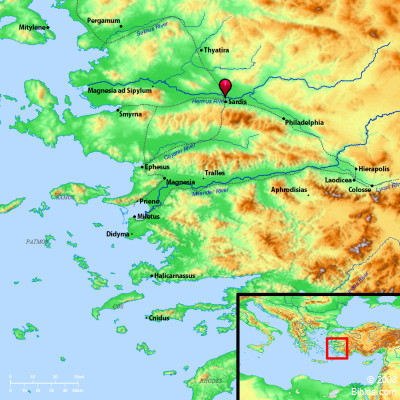Atlas  Sardis and surrounding region Maps Created using Biblemapper 3.0 Additional data from OpenBible.info Occurrences Revelation 1:11 saying, " What you see, write in a book and send to the seven assemblies : to Ephesus, Smyrna, Pergamum, Thyatira, Sardis, Philadelphia, and to Laodicea."Revelation 3:1 "And to the angel of the assembly in Sardis write: "He who has the seven Spirits of God, and the seven stars says these things: "I know your works, that you have a reputation of being alive, but you are dead. Revelation 3:4 Nevertheless you have a few names in Sardis that did not defile their garments. They will walk with me in white, for they are worthy. Encyclopedia SARDISsar'-dis (Sardeis): Sardis is of special interest to the student of Herodotus and Xenophon, for there Artaphernes, the brother of Darius, lived, and from there Xerxes invaded Greece and Cyrus marched against his brother Artaxerxes; it is also of interest to the student of early Christian history as the home of one of the Seven Churches of Re (1:11; 3:1;). It was moreover one of the oldest and most important cities of Asia Minor, and until 549 B.C., the capital of the kingdom of Lydia. It stood on the northern slope of Mt. Tmolus; its acropolis occupied one of the spurs of the mountain. At the base flowed the river Pactolus which served as a moat, rendering the city practically impregnable. Through the failure to watch, however, the acropolis had been successfully scaled in 549 B.C. by a Median soldier, and in 218 by a Cretan (compare Revelation 3:2, 3). Because of its strength during the Persian period, the satraps here made their homes. However, the city was burned by the Ionians in 501 B.C., but it was quickly rebuilt and regained its importance. In 334 B.C. it surrendered to Alexander the Great who gave it independence, but its period of independence was brief, for 12 years later in 322 B.C. it was taken by Antigonus. In 301 B.C., it fell into the possession of the Seleucidan kings who made it the residence of their governor. It became free again in 190 B.C., when it formed a part of the empire of Pergamos, and later of the Roman province of Asia. In 17 A.D., when it was destroyed by an earthquake, the Roman emperor Tiberius remitted the taxes of the people and rebuilt the city, and in his honor the citizens of that and of neighboring towns erected a large monument, but Sardis never recovered its former importance (compare Revelation 3:12). Again in 295 A.D., after the Roman province of Asia was broken up, Sardis became the capital of Lydia, and during the early Christian age it was the home of a bishop. The city continued to flourish until 1402, when it was so completely destroyed by Tamerlane that it was never rebuilt. Among the ruins there now stands a small village called Sert, a corruption of its ancient name. The ruins may be reached by rail from Smyrna, on the way to Philadelphia. SAR'DIS, the capital of Lydia in Asia Minor, on a site of great beauty, 48 ms. due e. from ancient Smyrna. Now called Sart, with extensive ruins. Its site is now unhealthy and few inhabit it. Strong's Greek G4554: SardeisSardis, the chief city of Lydia |



